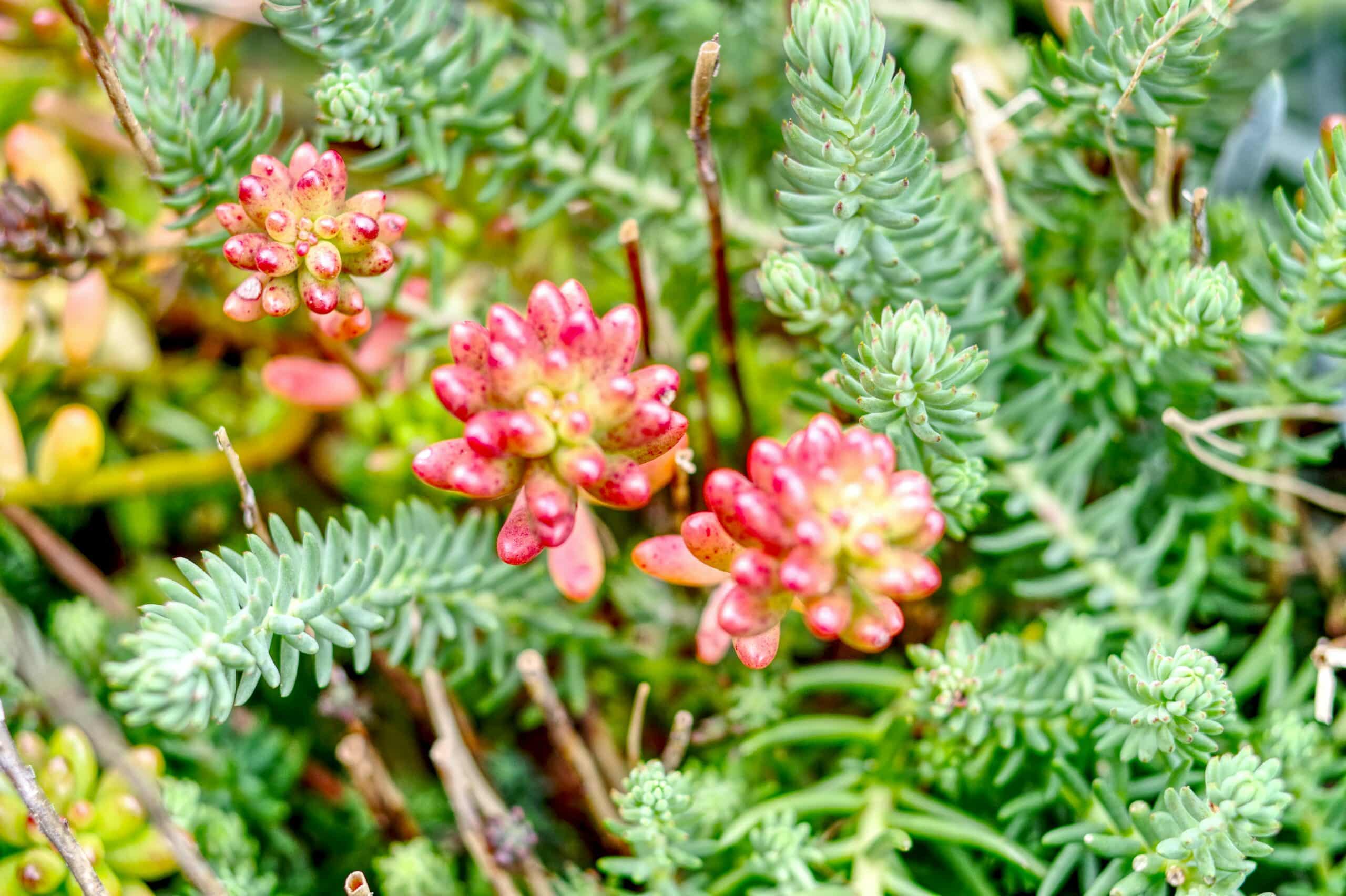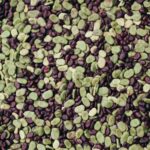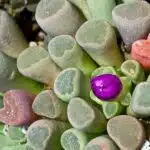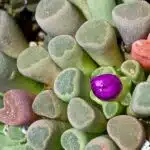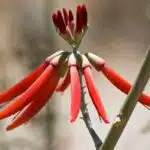Jelly bean succulents, with their unique shape and vibrant colors, are a sight to behold. Despite the delicate beauty of these plants, they are incredibly resilient and easy to care for. This makes them the perfect choice for novice gardeners who want to add a bit of color to their yard or home.
In this guide, we will discuss what jelly bean succulents need in order to thrive, from proper soil and light requirements to fertilization and propagation. Whether you’re an experienced gardener or just getting started, you’ll find everything you need to know about these fascinating plants here.
For those looking for a low-maintenance way to bring beauty into their garden or home without sacrificing quality or aesthetics, jelly bean succulents are the perfect choice. With proper care and maintenance, these plants can be enjoyed for years to come – so let’s get started!
What Is A Jelly Bean Succulent?
Have you ever seen a plant that looks like it’s made of jelly beans? If so, then you’ve likely come across one of the most unique succulents out there: the jelly bean succulent. But what is it exactly?
As a specialist in botany and gardening, I’m here to tell you all about this interesting plant. Jelly bean succulents are actually a type of sedum, which is an incredibly diverse genus of flowering plants. These succulents get their name from their small, round leaves that look like colorful jelly beans. They can range in color from shades of green to yellow, pink and even purple!
These plants may be small but they’re sure tough! The jelly bean succulent is quite drought-tolerant and easy to care for. As long as they get plenty of sunlight and well-drained soil, they’ll thrive in your garden or indoor container garden. Plus, they require minimal maintenance since they don’t need to be watered very often – making them perfect for busy people who want an easy-to-maintain plant!
So if you’re looking for something a bit different that will stand out in your garden or houseplant collection, try growing a jelly bean succulent! With its unique shape and vibrant colors, it’s sure to add some interest to your space – no matter where you choose to place it.
Where To Find Jelly Bean Succulents
If you are looking for a unique and eye-catching addition to your garden, the jelly bean succulent is the perfect choice. With their bright and vivid colors, these succulents will instantly brighten up any outdoor space. Plus, they are surprisingly easy to care for! So, where can you find these delightful plants?
Jelly bean succulents are currently available in many gardening stores or online retailers. When selecting a plant, look for one that is healthy with no signs of damage or discoloration. Also, make sure that the soil is moist but not soggy; this will ensure that your succulent has an easier time establishing itself in its new environment. Finally, it is important to note that jelly bean succulents prefer warmer climates, so if you live in cooler areas then you may need to provide some extra protection from cold temperatures.
When it comes to finding the perfect jelly bean succulent for your garden, don’t be afraid to experiment and try different varieties! You can even mix and match different types of plants for a truly unique look. Be sure to give your succulent plenty of sunlight and water on a regular basis – this will help keep them happy and healthy for years to come. TIP: If growing indoors, use grow lights or place your plant near a sunny window to ensure it gets enough light.
Benefits Of Growing Jelly Bean Succulents
Growing jelly bean succulents is like planting a tiny oasis in your garden. The vibrant colors and unique shapes of these plants will add life to any environment, creating an inviting atmosphere that everyone can appreciate. Here are some of the benefits you can expect from tending to these delightful succulents:
They require minimal maintenance: Jelly bean succulents, unlike other plants, don’t require regular watering or pruning.
Their shallow root system means no digging: These plants naturally grow low to the ground with shallow roots that make them perfect for container gardens and rock walls.
Unique foliage: The waxy leaves of these succulents come in a variety of colors, ranging from green and purple to red and yellow – making for some truly remarkable displays!
These robust plants offer the gardener plenty of options when it comes to landscaping, and they’re easy to look after too! With their low-maintenance needs, jelly bean succulents are the perfect choice for busy gardeners looking for a little bit of extra life in their space. Now that we’ve explored the benefits of growing jelly bean succulents, let’s move on to selecting the right ones for your garden.
Selecting The Right Jelly Bean Succulents
Selecting the right jelly bean succulents for your garden is like painting a masterpiece – it takes an eye for detail, finesse and a deep understanding of the underlying principles. Not only does this determine whether you will have a thriving garden full of life, but also one which showcases all its vibrant colors. As such, when selecting your jelly bean succulents there are several key points to consider:
- Sunlight: Jelly bean succulents require bright sunlight to thrive, so make sure you choose varieties that can tolerate the amount of light in your location.
- Soil type: Choose a soil that has good drainage and is slightly acidic for optimal growth.
- Hardiness: Select hardy varieties that can tolerate varying temperatures and humidity levels.
These considerations are important to ensure the lasting health of your jelly beans plants. But it doesn’t end there – care must be taken in preparing the soil before planting as well. It is essential to create an environment conducive to root development with adequate aeration and optimal water retention capacity if you want to give your succulents the best chance at survival. This involves adding organic matter such as compost or mulch and adjusting pH levels by adding lime if necessary.
By taking these steps, you’ll be on track to successfully growing and nurturing beautiful jelly bean succulents in your garden!
Preparing The Soil For Growing Jelly Bean Succulents
One of the most delightful aspects of gardening is that it allows us to bring nature into our homes. For those looking for a splash of color and whimsy, growing jelly bean succulents provides just such an opportunity. Let’s get started with preparing the soil for these unique plants.
The foundation for successful growth starts with the soil. To ensure your jelly beans thrive, it’s important to determine the best type of potting soil mix. A well-draining mixture is essential as succulents don’t tolerate soggy conditions:
- Start with a high-quality potting mix designed specifically for cacti and succulents;
- Add in some perlite or pumice for extra drainage;
- Mix in a few handfuls of topsoil for additional nutrients.
Once you’ve determined the ideal soil combination, you can begin planting your jelly beans. Before doing so, however, it’s important to ensure that the pH level is adequate for their growth; ideally 5.5 – 6.5 on the pH scale should be maintained. If necessary, adjust the pH level by adding appropriate amendments such as peat moss or lime powder to make sure your succulent babies have all they need to flourish! With everything in place, you’re ready to start planting your jelly bean succulents and enjoy their beauty in your home or garden!
Planting Jelly Bean Succulents
Once the soil is ready for planting, jelly bean succulents can be added to the pot. The best way to plant them is to place them at a depth of about two inches. When planting them in an outdoor area, it’s important to dig a hole that is twice as deep as the height of the succulent and twice as wide. This will give the roots enough space to spread out and find nutrients in the soil. It’s also crucial to make sure that there are no air pockets around the root system, which can cause root rot.
Be sure to firm up the soil around the succulent after planting, with gentle pressure from your hands or a trowel. It’s also a good idea to water it immediately after placing it into its new home, until you see some moisture on the surface of the soil. This will help ensure that it’s getting off to a good start with healthy roots and leaves.
When caring for jelly bean succulents outdoors, keep in mind that they may need more water than other types of succulents since they have more delicate leaves and stems. As such, they should not be left in standing water for too long, as this can lead to root rot or other diseases due to lack of oxygen in the soil. Additionally, make sure that you provide plenty of sunlight for your plants—they need at least four hours per day during summer months and six hours during winter months for optimal growth.
TIP: Take care when transplanting jelly bean succulents from one pot to another; their small root systems can easily become damaged if handled too roughly!
Caring For Jelly Bean Succulents
Taking care of jelly bean succulents is a relatively simple task, but an important one for ensuring their health and longevity. By understanding the needs of your plants, you can create the perfect conditions for them to thrive. Thus, by engaging in proper care practices, you can enjoy these beautiful plants for years to come.
Unsurprisingly, light is essential for jelly beans succulents to grow and remain healthy. Like other succulents, they prefer plenty of bright indirect sunlight with some direct sun in the mornings or late afternoons. As with all succulents, take care not to place them in direct sunlight during midday hours as this can burn their leaves and cause discolouration.
It’s also important to be mindful when watering jelly bean succulents. They need more water than most other types of succulents because they are less drought-tolerant, so it’s best to water them regularly but shallowly. Make sure that their soil drains well and never let them sit in waterlogged soil as this will lead to root rot and ultimately kill the plant. With careful attention and regular check-ins on your jelly beans’ health, your little green friends will be happy and thriving! Moving onto the next step: how do we ensure our jelly bean succulents receive adequate hydration?
Watering Jelly Bean Succulents
Watering jelly bean succulents is not just a task, it’s a divine ritual! It’s essential to maintain their health and vitality, so you must pay close attention to how much water your succulents need and when they need it. As a botanist who specializes in gardening, I can assure you that if done correctly, the results will be stunningly gorgeous plants with the most vibrant of colors.
The key to successful watering is understanding what kind of soil your succulent needs. If the soil is too dry, it won’t absorb enough water; if it’s too wet, it can lead to root rot! The ideal soil should be slightly damp but never soggy. You should also avoid overwatering as this can cause drooping leaves and other issues.
To ensure your succulent gets the perfect amount of water, use a spray bottle or water from the bottom up. When spraying from above, make sure to direct the nozzle towards the roots rather than on the leaves. This way, you’ll avoid any potential damage or fungal growth. Additionally, consider using a moisture meter or probe to check the moisture level before watering; this is an invaluable tool for monitoring your plant’s health and preventing overwatering.
With these tips in mind, watering your jelly bean succulents will be easy-breezy! But don’t forget that they still need proper nutrition – let’s explore what types of fertilizers are suitable for these precious plants next!
Feeding Jelly Bean Succulents
Caring for jelly bean succulents can seem like an overwhelming task, but with a few simple steps, you’ll be rewarded with lush and healthy plants. Feeding is one of those critical steps that should not be overlooked. And while the process may vary depending on the type of succulent, there are some general guidelines to keep in mind.
For most jelly bean succulents, fertilizer is not necessary if the plants are grown outdoors in rich soil. However, if you’re growing them indoors or in containers, a balanced liquid fertilizer should be applied every two weeks during their growing season – typically from early spring until late summer. Fertilizers formulated specifically for cacti and succulents are ideal because they don’t contain nitrogen-rich compounds that can burn and damage the roots of these delicate plants. Additionally, it’s important to water your jelly bean succulents before fertilizing to help prevent nutrient burn.
It’s also important to remember that too much fertilizer can be just as damaging as too little. Overfeeding your jelly bean succulents can cause foliage discoloration and root rot, so always follow the instructions on the product label closely when applying fertilizer. With proper care and attention, you’ll find that your jelly bean succulents will flourish with minimal effort!
Pruning Jelly Bean Succulents
Pruning jelly bean succulents is an essential part of their care, but it can be intimidating for the novice gardener. Having a basic understanding of pruning techniques can make all the difference in how healthy and vibrant your succulent is. It’s worth exploring whether or not regular pruning will help keep your jelly bean succulent in top shape.
Succulents have a unique growth pattern that requires careful pruning. The basic principle is to trim off any dead or dying foliage as well as any overcrowded branches and stems. This helps encourage new growth and allows more light and air to reach the lower parts of the plant. If left unchecked, the plant may become leggy and sparse looking, which can weaken its overall health. It’s important to use sharp, clean scissors when pruning your jelly bean succulent to avoid damaging it further.
Pruning should be done at least once a year in order to maintain its shape and vigor. When tackling larger plants, it’s best to start from the bottom up, removing any dead leaves or stems first before moving on to other branches or stems higher up on the stem. Be sure not to over-prune as this could lead to stunted growth or even death of the plant if too much damage has been done. With regular pruning, you’ll find that your jelly bean succulent maintains its beauty and vitality for years to come.
By following these simple guidelines for proper pruning, you can ensure that your jelly bean succulent remains healthy and vibrant while protecting it from pests and diseases down the line.
Protecting Jelly Bean Succulents From Pests And Diseases
Protecting jelly bean succulents from pests and diseases is an important part of their care. Just like any other plants, these succulents are prone to insect infestations and fungal infections. The key is to be proactive by taking steps to prevent problems before they occur.
Imagining your succulent garden being attacked by pests or diseases can be quite a scary thought, but luckily there are some simple steps you can take to keep your plants safe and healthy. Here are three things you can do:
• Keep the area around the succulents weed-free and water only when necessary. Weeds provide shelter for pests and too much water creates an ideal environment for fungi.
• Remove any dead or diseased leaves or stems from the plant. This will help stop any infection from spreading.
• Check the plants regularly for signs of insects or diseases, such as discolored leaves or spots on the stem. If you spot something suspicious, you should take immediate action to address it before it spreads further throughout the plant.
As a specialist in botany and gardening, I recommend that gardeners exercise caution when dealing with potentially dangerous pests and diseases, as they can easily spread through your entire garden if not addressed quickly enough. Taking preventative measures such as weeds control and regular inspections will help keep your succulents safe from harm and ensure that they thrive in your garden. With this knowledge in hand, you’ll be well on your way towards having a beautiful garden full of healthy jelly bean succulents! To ensure long-term success with growing jelly bean succulents, it’s also important to learn how to propagate them properly so they can thrive in many different climates and environments.
Propagating Jelly Bean Succulents
Approximately 70% of succulent plants are propagated through cuttings, making it a fundamental part of the growing process. Propagating jelly bean succulents is no exception and can be done in multiple ways. As a specialist in botany and gardening, I will provide you with an engaging guide to growing jelly bean succulents from propagation:
• Division: This method involves carefully separating parts of the existing plant into two or more clumps. It’s important to make sure that each division has plenty of healthy leaves and roots so that it can survive on its own. • Cuttings: Taking stem or leaf cuttings is an easy way to propagate jelly beans. For stem cuttings, use a sharp knife or scissors to take off several inches of the stem just below a node (where the leaves meet). Leaf cuttings should include the entire leaf and part of the stem attached to it.
Once you have your divisions or cuttings ready, you’ll need to prepare them for planting. Start by removing any damaged or dried out leaves or stems, then dip them in rooting hormone powder if desired. Then place them in moistened soil or perlite-peat mix and keep them out of direct sunlight until they start rooting. Make sure to water regularly but not too much so as not to cause root rot.
With proper care and attention, your jelly bean succulent divisions and cuttings will soon take root and grow into beautiful new plants for your garden! Transplanting these new plants allows you to create an even larger display of jelly beans in your garden.
Transplanting Jelly Bean Succulents
With the right care, Jelly Bean Succulents can grow and thrive in almost any climate. In fact, many of these succulents are able to survive temperatures as low as 0°F! This makes them a great choice for gardeners who need something hardy and low-maintenance.
Once your Jelly Bean succulent has grown big enough, it’s time to transplant it into a larger pot. Transplanting is an important step in the life cycle of your succulent and should be done with care. Start by picking out a new pot that is larger than the one you currently have. Make sure the pot you choose has drainage holes at the bottom so excess water can escape.
Next, carefully remove your Jelly Bean succulent from its current pot and place it in the new one. Fill in around the base with soil that is specially formulated for succulents. After planting, water your succulent lightly but thoroughly until water runs out of the drainage holes. This helps settle the roots firmly in their new home!
Transplanting your Jelly Bean succulent will give it plenty of room to grow healthy and strong over time. Following these instructions will ensure that your plant is able to get established quickly and easily in its new environment!
Troubleshooting Common Issues When Growing Jelly Bean Succulents
The jelly bean succulent is a unique and beloved plant by many gardeners, with over 90% of people who own them being pleased with the outcome. This article intends to discuss common issues one may face while growing jelly bean succulents, so they can be pre-empted and prevented.
Firstly, jelly bean succulents are susceptible to sunburn if exposed to too much direct sunlight. To prevent this, it’s important to place them in bright spots where they’ll get indirect sunlight or shade during the hottest part of the day. They should also be watered sparingly as too much water can cause root rot or fungal diseases, leading to wilting leaves and eventual death.
It’s also recommended that you check for pests such as mealybugs or spider mites often, as these can wreak havoc on your plants if not caught early enough. Regular pruning is also important for keeping your jelly beans healthy – prune away any dead leaves and stems from time to time to ensure proper air circulation throughout the plant.
These tips combined will help keep your jelly bean succulent thriving for years to come! With careful monitoring and maintenance, you’ll be able to enjoy this beautiful houseplant for a long time.
Tips For Growing Jelly Bean Succulents
Growing succulents is a timeless pursuit – an ancient art that has captured the hearts of gardeners for generations. Jelly bean succulents, with their vibrant colors and unique shapes, make this pastime even more captivating. These hardy plants require just the right amount of care to thrive. Here are some tips for growing jelly bean succulents.
First and foremost, proper drainage is essential for successful cultivation. Make sure your soil is well-draining and not too moist; otherwise, the roots may rot. Additionally, provide bright but indirect sunlight; these plants don’t need direct sun to flourish. When watering jelly beans, make sure to only add enough moisture to keep the soil from drying out completely; overwatering can cause root rot or dryness on the leaves.
Lastly, be mindful of potential pests or diseases that might affect your jelly bean succulent’s growth. These include mealybugs and spider mites which can cause discoloration or wilting in the leaves. If you spot any signs of infestation or disease, take prompt action by removing affected parts of the plant and treating it with an appropriate pesticide or fungicide solution. With these tips in mind as well as regular monitoring, your jelly bean succulent should thrive in its new home!
Frequently Asked Questions
Is It Necessary To Fertilize Jelly Bean Succulents?
It seems counterintuitive to believe that fertilizing something as seemingly perfect and delicate as jelly bean succulents is necessary. After all, why would you need to supplement the natural beauty of this species by providing extra nutrients? But don’t be fooled – these plants have unique needs that must be met in order for them to thrive. As a specialist in botany and gardening, I’m here to explain why it’s essential to fertilize your jelly bean succulents.
The first thing you should know is that jelly bean succulents are incredibly sensitive to their environment, meaning they require more care than other types of plants. Because of this sensitivity, they can easily become stressed or malnourished if their soil isn’t adequately enriched with minerals and humus. Fertilizing your jelly bean succulents regularly can help ensure that they receive the nutrients they need to stay healthy and happy.
Finally, while fertilizer might seem like an extra step in the care process, it’s actually one of the most important steps you can take when growing these beautiful plants. Fertilizer will not only help provide your succulents with key nutrients but also encourage strong root development and flowering. Additionally, fertilizer can help protect against common pests and diseases, making it an invaluable tool for ensuring healthy plant growth over time.
For anyone looking to get the most from their jelly bean succulent garden, regular fertilization is essential for success. This simple act will provide your plants with the nourishment they need for a long life full of beauty and vitality – so don’t skip out on this important part of your plant-care routine!
What Is The Best Time Of Year To Transplant Jelly Bean Succulents?
Transplanting succulents can be a tricky process, and the timing is particularly important for jelly bean succulents. As expert botanists and gardeners will tell you, it’s essential to find the right time of year to transplant these delicate plants. Fortunately, there are some key tips and tricks that can help you get it just right.
For optimal success, springtime is the ideal season for transplanting jelly beans succulents. This is when they’ll have plenty of energy after their winter dormancy and before the summer heat sets in. They’ll also have access to plenty of rainwater during this time so they can establish themselves in their new homes quickly and easily.
When transplanting these succulents, make sure that you prepare a well-draining soil mix that includes an organic material such as compost or peat moss. Additionally, avoid any direct sunlight while they’re getting established in their new environment. With these simple tips, your jelly bean succulents will be thriving in no time!
Can Jelly Bean Succulents Be Grown Indoors?
Growing jelly bean succulents indoors can be an exciting experience for the home gardener. The vivid colour of these succulents and their unique shapes add a touch of the exotic to any room. With a little bit of knowledge and care, you’ll soon be enjoying your own indoor succulent garden!
Firstly, it is important to choose a spot with plenty of light. Jelly bean succulents need bright indirect light to thrive indoors, so placing them near a window which gets sun in the morning or afternoon is ideal. It’s also important to keep the temperature consistent by avoiding drafts and ensuring that the room doesn’t get too hot or cold during the day.
When it comes to watering, it is best to err on the side of caution when growing jelly bean succulents inside. Overwatering can easily lead to root rot, so make sure that you allow the soil to dry out completely between waterings and use only a small amount of water each time – just enough to moisten the top few inches of soil. You should also fertilize every few weeks with a balanced liquid fertilizer for succulents during their active growing season (spring and summer).
With proper care and attention, your jelly bean succulents will thrive indoors! Their vibrant colours will bring life into your home while helping you create an oasis where you can relax and take pride in having nurtured something beautiful.
How Often Should Jelly Bean Succulents Be Pruned?
Jelly bean succulents may be some of the most unique and exotic plants out there, but they require quite a bit of care and attention to thrive. Pruning is an essential part of this care, so how often should one prune their jelly beans? Ironic as it may seem, the answer is actually quite simple.
As a specialist in botany and gardening, I believe that the best way to serve others who have jelly beans is to provide them with the information they need to properly prune their plants. In general, jelly beans should be pruned every three months or so:
- Trim off any dead or dying leaves;
- Remove any brown patches from the leaves;
- Cut away any stems that have grown too long;
- Rehydrate dehydrated leaves;
- Give the plant an overall shape by cutting away at any lanky stems.
To ensure healthy growth, make sure to use sharp scissors or shears when pruning your succulent. A dull tool can cause damage to your plant’s delicate leaves and stems. It’s also important to remember that while pruning can help maintain the shape of your jelly bean succulent, too much can actually do more harm than good! So, take care not to over-prune your jelly bean and enjoy its unique beauty for years to come!
Can Jelly Bean Succulents Be Grown In A Container?
Yes, jelly bean succulents can be grown in containers. These plants are particularly well-suited to container gardening due to their small size and ability to store water for long periods of time. Container gardening is an excellent option for gardeners who have limited space or those who want to bring a little bit of greenery indoors.
When choosing a container, make sure it’s shallow and has drainage holes at the bottom. It should also be big enough to accommodate the plant’s roots without overcrowding them. Succulents prefer well-draining soil, so use a fast-draining potting mix that contains sand, perlite, and pumice.
Once you’ve planted your jelly bean succulent in its container, place it in an area with bright indirect light. Allow the surface of the soil to dry out before watering again; water too often can lead to root rot. Fertilize your succulent once every two weeks during the growing season for optimal growth—just be sure not to overfertilize!
TIP: If you’re looking for a way to add some color and interest to your container-grown jelly bean succulent, consider planting other types of succulents around it. This will provide both visual interest and extra protection against root rot if any of the plants become overwatered.
Conclusion
The Jelly Bean Succulent is a delightful, low-maintenance plant that can be a great addition to any garden. With the right care and attention, these succulents can thrive in almost any environment. Proper fertilization and pruning will help ensure healthy growth, while transplanting and potting are important steps for successful propagation.
For those seeking an easy-care option with vibrant colors, Jelly Bean Succulents are an ideal choice. They’re hardy, resilient plants that require minimal effort to keep thriving. By providing the essential nutrients and light needed for proper development, you’ll be rewarded with bountiful blooms of bright colors each season.
Overall, Jelly Bean Succulents bring an abundance of beauty to your outdoor or indoor space with no hassle involved. Their low-maintenance nature makes them a perfect fit for even novice gardeners or those looking to add some eye-catching color to their home without all the fuss. So if you’re looking to add a bit of interest and life to your environment, consider adding these stunning succulents to your set up!

